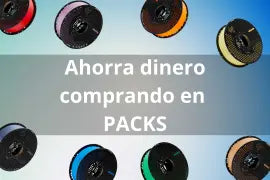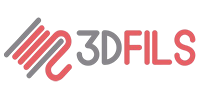Types of 3D filaments
Comparative guide to 3D filaments
On this page, you'll find a summary table with the main properties of each of our filaments. It's designed to help you quickly compare all our products and easily select the one that best suits your needs. If you need more detailed information, you can always consult the technical data sheets.
|
|
esFil PLA MAX
Buy
|
esFil PETG MAX
Buy
|
esFil PETG MAX Matte
Buy
|
eFil TPU 85A
Buy
|
eFil TPU 90A
Buy
|
eFil TPU 60D
Buy
|
| Physical properties |
Density |
1.24 g/cc |
1.29 g/cc |
1.29 g/cc |
1.19 g/cc |
1.19 g/cc |
1.19 g/cc |
| Thermal properties |
Melting temperature |
165 - 180 ºC |
210 ºC |
220 ºC |
225 ºC |
225 ºC |
225 ºC |
| Thermal properties |
Glass transition temperature |
55-60ºC |
80 ºC |
80 ºC |
-38 ºC |
-38 ºC |
-38 ºC |
| Mechanical properties |
Tensile strength |
51 MPa |
50 MPa |
50 MPa |
37 MPa |
42 MPa |
44 MPa |
| Mechanical properties |
Tensile elongation |
3.31% |
4% |
4% |
550% |
440% |
380% |
| Mechanical properties |
Impact |
IZOD 118 J/m2 |
4.4 KJ/m2 |
4.4 KJ/m2 |
N/A |
N/A |
N/A |
| 3D printing properties |
Printing temperature |
200 -220 ºC |
230 -240 ºC |
240 - 260 ºC |
220 -240 ºC |
220 -240 ºC |
220 -240 ºC |
| 3D printing properties |
Nozzle |
All sizes and materials |
All sizes and materials |
All sizes and materials |
>0.4 mm / All materials |
>0.4 mm / All materials |
>0.4 mm / All materials |
| 3D printing properties |
Heated bed temperature |
50 ºC |
80-90 ºC |
80-90 ºC |
No |
No |
No |
| 3D printing properties |
Adhesion to the bed |
Lacquer, Glue stick |
Lacquer, Glue stick |
Lacquer, Glue stick |
Lacquer, Glue stick |
Lacquer, Glue stick |
Lacquer, Glue stick |
| 3D printing properties |
Layer fan |
50-100% |
0 - 60 % |
0% |
50-100% |
50-100% |
50-100% |
| 3D printing properties |
Printer closed? |
No |
No |
No |
No |
No |
No |
| 3D printing properties |
Print speed |
< 300 mm/s |
< 300 mm/s |
< 300 mm/s |
< 80 mm/s |
< 80 mm/s |
< 80 mm/s |
| 3D printing properties |
Pre-drying? |
Optional |
Optional |
Optional |
Mandatory |
Mandatory |
Mandatory |
| 3D printing properties |
Drying the filament |
60 ºC 8h |
65 ºC 8h |
65 ºC 8h |
70ºC 8h |
70ºC 8h |
70ºC 8h |
esFil PLA MAX:
PLA MAX is a popular 3D printing material due to its ease of use and wide color gamut. It's a great choice for beginners, as it doesn't require a heated bed on most printers and has good adhesion. However, PLA MAX has limitations in terms of thermal resistance and isn't suitable for high-temperature applications. It can also be prone to warping over time when exposed to moisture.
Advantages:
- Easy to print and good adhesion to the heated bed.
- Wide range of colors available.
- Does not require a heated bed on most printers.
Disadvantages:
- Lower thermal resistance than other materials.
- Less flexible than materials like TPU.
- It is not resistant to long-term humidity.
esFil PETG MAX:
PETG MAX is known for its thermal and chemical resistance, making it ideal for engineering applications and durable parts. While it offers good mechanical properties, such as tensile strength, it can be more demanding in terms of printing temperature and heated bed control. It is often used in applications where strength and durability are required, but attention must be paid to print settings.
Advantages:
- Good thermal and chemical resistance.
- Adequate mechanical resistance.
- Suitable for engineering applications and durable parts.
Disadvantages:
- Requires higher printing temperatures.
- It tends to warp if the bed temperature is not properly controlled.
- More prone to strings and shrinkage than PLA.
eFil TPU:
TPU is a highly flexible and elastic material that is well-suited to applications requiring flexibility and cushioning, such as phone cases and shoe inserts. One of its main advantages is the availability of different hardnesses, allowing the material to be tailored to various needs. However, printing with TPU can be more complicated due to its flexibility, and specific configurations are required to avoid extrusion issues.
Advantages:
- Great flexibility and resistance to impacts.
- Ideal for elastic and shock-absorbing parts.
- Variety of hardnesses available for different applications.
Disadvantages:
- It may be more difficult to print due to its flexibility.
- Requires specific settings on the printer.


